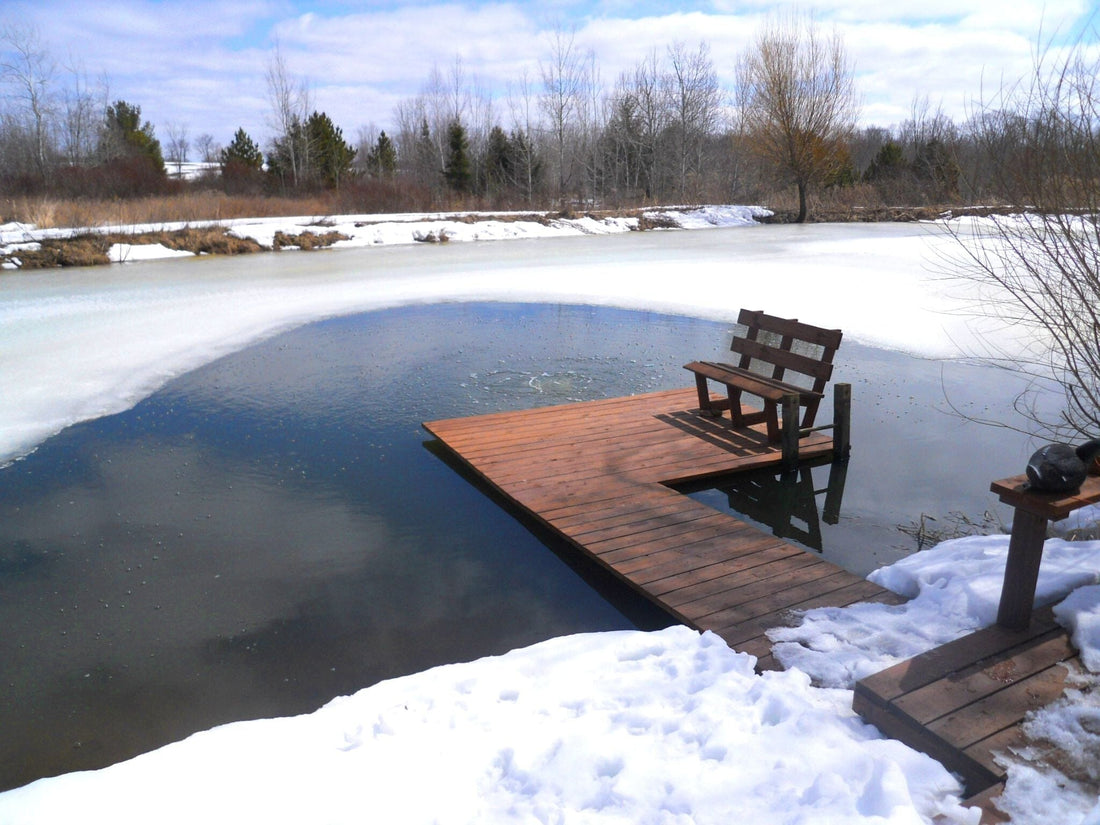Don’t let the word “kit” throw you off. Pond aeration systems, whether they be fountains or aerators are typically sold in kits, usually with minimal assembly. Factories have already tried and tested different parts and then sourced them for quality and cost efficiency. You can always build your own, and some people do. For a surface aerator, you will need four parts: some kind of flotation device, a pump with a long cord, a nozzle (you can use a male PVC cap, preferably 1 ½” or larger), and a PVC or ABS pipe to connect the pump to the nozzle. To create the nozzle pattern you would drill holes into the PVC cap at different angles and you would probably have to make a few different attempts before you find a pattern you like and that is even.
There are basically three parts to a bottom aeration system: an air compressor, a diffuser, and tubing that connects the air compressor at the shore to the diffuser at bottom on your pons. There are different kinds of compressors and you need to make sure that your will pump air to enough depth for your pond. The tubing will need to be weighted, either by you or by you can buy weighted tubing. The diffuser can be made as simply as drilling holes into a piece of PVC connected to the tubing. There is one other thing you will most likely, though not always, need: housing for the compressor to protect it from the elements (unless you have a compressor that is already weather-proofed (most are not). If you make your own housing, make sure it is well-ventilated, preferably with an exhaust fan, in order to keep the compressor from overheating.
Usually, when it comes to DIY, it is not worth the trouble, and the parts you buy one at a time could be more expensive than a whole kit from a manufacturer, which sources hundreds or thousands of the parts at once at a discount. But it could be a project you enjoy doing and it is possible to save some money if things are well-planned. But when it comes to pond aeration, try not to skimp on either the aeration pump for pond or the compressor.
Surface aerators, the kind that float on the water, only work to a depth of six and maybe seven feet, so you need to know how deep your pond is for proper aeration. If it is deeper, then you need to invest in a bottom aerator. These tend to provide the most “bang for your buck”; that is, you can aerate for much less electricity cost each month and typically the units cost less to buy. The drawback is that there is no display. All the action is taking place under the surface.
 Picture depicting bottom aeration as photographed from the top. Notice not really any surface action or display.
Picture depicting bottom aeration as photographed from the top. Notice not really any surface action or display.
Things to Consider:
When buying a surface aerator, a rule of thumb is usually the more elegant the display, the less aeration. The nozzles that create the displays do so with a series of holes in a pattern, restricting the flow of water. To get tall displays the holes need to be even more restrictive. The most efficient kind of surface aerator is a float and a pump with no display whatsoever. The pump have a propeller on top and the water kind of bubbles out of the top, though the bubbles can be very large. Believe it or not, you can add lights to these and they can be pretty at night, because though the action is not tall or very wide, there is plenty of action.
 Decorative Surface Aerator with Display
Decorative Surface Aerator with Display
V-shaped aerator patterns also use a propeller, and there is a large hole at the center of the nozzle, but still, there is some restriction compared to a pure surface aerator.
 V-shaped Pattern with Lights
V-shaped Pattern with Lights
Decorative fountains typically have several, maybe even twenty holes in them to form their unique patterns, but these provide the least aeration of the surface aerators. Still, some decorative fountains, like those made by Kasco, provide quite a bit of aeration even with intricate patterns. Again, if height is what you are after, usually aeration will suffer.
 Surface Aerator, bubbles, no display
Surface Aerator, bubbles, no display
Bottom aeration
It is essential you know the depth and size of your pond, and also its shape. We ask customers to get good measurements. Islands, large curvatures, connected ponds—these all affect the kind system you will need (how many diffusers, how much horsepower, how much tubing, etc.) If you want to know the total acre feet, volume, or other valuable stats about your pond you can visit our pond size and electrical use calculator page here:
Some of the benefits of bottom aeration:
- Great for depths 8 ft. and deeper
- No electricity required in the water
- Speeds up organic decomposition
- Creates open water preventing ice damage
- Designed for continuous operation 24 hours per day
- Low electricity bill
When it comes to bottom aeration, we have a bias for Kasco units (actually we are biased toward Kasco for all aeration systems, as they have multiple engineers and biologists on staff). Their bottom aerators will probably cost a bit more than a lot of competitors, but we think you will enjoy their quality and reliability. Here’s some photos of different systems by Kasco that are available:

Very large Kasco aeration system with 4 diffusers
 Post mount compressor box
Post mount compressor box
 Bottom aerator cutting hole in ice
Bottom aerator cutting hole in ice
For more information on pond fountains or bottom aerators, please call us or email your questions.

